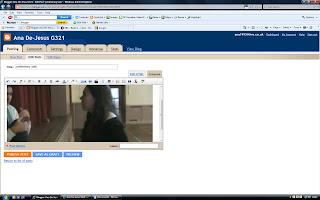 |
| Film screenshot |
In regards to the editing techniques I have discovered a great deal since the succession of the preliminary task as before I had no real experience within Adobe software through the use of transitions, cutting footage, conversions etc .My primarily dominant role within the group was essentially to provide a detailed analysis of the work which we had completed within the lesson, taking down the notes of what we did. Through the detailed analysis I learnt a great deal about the progression of piecing together a film as well as the application of editing effects in regards to which would fit our pervading mood/atmosphere/ genre. I also increased my overall comprehension of how to load and download videos in appropriation to our opening two minutes such as company titles, Working Title and Universal.
Another particular skill was the layering of non-diegetic sound such as the use of the singular dialogue Im watching you' where we tweaked the volume audio levels , allowing the filtering of sound to be particularly loud at this point to display the breathiness which increases tension and suspension. This was also particularly evident through the use of the non-diegetic soundtrack which faded into the succession of the dream sequence and slowly faded out as the dialogue became apparent. Another significant element of editing comprehension was the importance of looking at the type of shot we entailed the usage of to provide clear viewing for the audience as well as having a variation of shot experimentation's.
In terms of camera work it was important to determine camera movements of a particular frame. For example some shots were filmed unsteadily ( evidential basis for this can be seen in several of the last dream sequence shots) to express the vulnerability of my character as I try to escape, contrasting against the still shots which slows the pace of the film down, allowing the audience time to think and determine as to what is about to happen. This also can give the frame a particular depiction of the situation that is occurring. For example there is a shot where Zoe is leaning out of the tree and the significance of the shot lies in the position of her hands, clenched barbarically( mid shot).Within this shot you get a real sense of her sinisterness which is not as apparent in other shots.A particular shot which evokes meaning is a canted angle shot which makes the audience feel uneasy particularly when used in the context of horror genre movies, as essentially it frames the intensity of their eyes which is often layered with heavy make-up to express the dominance which they hold over others. Long shots, brief shots and the rule of thirds have been applied to our filming and are techniques which are used effectively within our final piece.
The 180 degree rule is also another significant factor which you have to take into consideration otherwise it will incorporate a violation of continuity, making the frames seem out of sync and the audience may feel distant in terms of the positioning of the characters. Shot/reverse shot are traditionally used in conversations , although we did not enable this method to our horror( due to to the absence of sound)but we did use this in our preliminary task so at least we can now have the knowledge of this, so that we may use it again .
Match on action we felt was one of the most complex elements to take into consideration when filming as we had to ensure that the characters were always in the right place at the right time. This was especially difficult when cutting footage as sometimes the frames would become out out of sync, with a differential position to the latter frame.
As a conclusive opinion I feel that our preliminary task was a good use of practice as it allowed us to have our first shot at filming as well as understanding how to build a narrative within a mixture of variating shots. It also gave us the opportunity to think about how we can improve on our year 13 task as we made alot of mistakes, some of which we cannot change at this present moment.

No comments:
Post a Comment